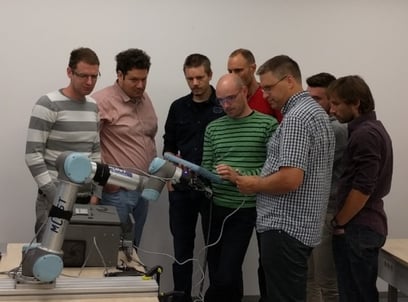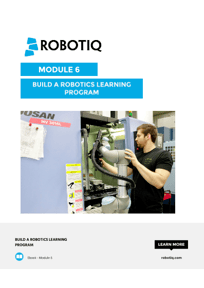How to Create an Effective Robotics Training Program

When done well, robotics training can take your business to new heights. But, how do you make sure it's effective? Here's how to build a training program which truly benefits your business.

Collaborative robots have made it very easy to add automation to your business. They are simple to program so people are starting to ask "Should I train my team in robotics?"
We are seeing changes in how businesses source their robotics knowledge. In-house expertise is on the rise, and with good reason. Training your team allows them to maximize their use of collaborative robots and implement more innovative applications.
There's only one big roadblock to making it happen: How can you ensure that training will be an effective investment, not an expensive mistake?
The Challenge of Effective Training
 Most of us recognize the benefit of ongoing training. We also recognize that not all training is created equal. Blindly investing in a training program can end up creating more problems than it solves.
Most of us recognize the benefit of ongoing training. We also recognize that not all training is created equal. Blindly investing in a training program can end up creating more problems than it solves.
Unfortunately, there are worrying signs that, on average, training in business is falling short. It was recently reported that employees are starting to take matters into their own hands — US employees now source 84% of training themselves, because their employers don't provide it.
When it comes to collaborative robotics, there are huge benefits to providing training systematically from the top down. One of the most compelling reasons to choose in-house expertise is that it gives workers a feeling of ownership of the robot. It makes sure everyone is "on the same page" which leads to better innovation in products and robot applications.
Robotics training is well worth the investment, but you have to plan it in the right way.
The Solution for Effective Training
To ensure your training program will be effective, start from your business needs and work up. This means following a series of structured steps:
- Assess the big picture goals of your business.
- Align these goals with the benefits of in-house robotics expertise.
- Quantify your existing resources.
- Assess which resources are most valuable for your move to in-house expertise.
- Get your stakeholders on board, both the technical team and other affected groups of employees.
- Identify key applications for robotics.
- Use these key applications to determine which new skills are necessary.
- Finally, you are ready to look at types of training and implement a training plan.
(If this seems like a lot of steps, read on to hear the simple way to get them done. It's not as much work as it sounds.)
Select Your Training Types
There are various training options to choose from. Some are more costly. Others will take more time or attention.
Here are some of the popular methods for robot training:
|
Less Costly |
More Costly |
|
On-the-job coaching and mentoring |
One-to-one tutoring |
|
Job shadowing |
Seminars |
|
Self-directed study |
College courses |
|
Video presentations |
External group workshops |
|
E-learning |
In-house consultant training |
A good training program will use a mix of the different types.
You will probably use an external supplier for your initial robot training. However, as the level of in-house expertise increases in your business, members of the team can take over some of the training burden. This is why it is so important to involve your stakeholders from early on, otherwise they may resist what they see as extra work.
The Simple Process for Creating an Effective Training Program
Here at Robotiq, we want to make it as easy as possible for you to start training your own team of in-house robotics experts.
 We have created a series of eBooks to help you out. We've taken key business skills, applied them to robotics expertise and thrown away anything which doesn't affect robotics.
We have created a series of eBooks to help you out. We've taken key business skills, applied them to robotics expertise and thrown away anything which doesn't affect robotics.
The result? A clear, straightforward process which you can apply immediately to your own business.
The eBooks are arranged into 10 modules. Together they guide you through the whole process of developing a robotics team, from assessing your business needs, to implementing your training program and measuring the effectiveness of the program.
Module 6 is available to download right now. In this hands-on worksheet, you will plan your robotics training so that it aligns with the strengths and needs of your business.
First, Get the Team on Board and Pick Specific Applications
If you haven't already, you should definitely check out the first five modules. They guide you step-by-step you through the whole process I listed above. They discuss why you need in-house robotics expertise, how to assess the robotics needs of your business, how to get the team on board, and how to pick the best applications for your business.
Next, Create an Amazing Robotics Learning Program
Module 6 guides you through the process of designing an effective robotics training program.
With the help of your stakeholder groups (which you identified in Module 4) you will learn:
- How to efficiently train your workforce by grouping their learning goals.
- How to budget for training.
- How to compare training options by their initial investment and ongoing costs over five years.
- How to finalize your training plan with the team.
- How to incorporate your training program into the calendar to ensure its success.
At the end of this module, you will have implemented a solid robotics training plan. What's more, you can be confident that it aligns with your long-term business goals.
How would you describe the culture of training in your business? How are you getting on with the modules? What questions do you have about the process? Tell us in the comments below or join the discussion on LinkedIn, Twitter, Facebook or the DoF professional robotics community.









Leave a comment